Do you need a theoretical framework that will guide you in conducting your research? Here are 5 important points to remember when preparing one. I provided an analogy as springboard to a full-blown write-up on this intriguing part of a research paper.
Why complicate things with more jargon if you can explain it in a down-to-earth fashion? I’m reminded of a popular scientist I met who told me that a good research is good if it’s too complicated to understand for the layperson or even a beginning researcher.
I did not show my disapproval upon hearing his remark, but deep inside, I feel sad why such a seasoned and respected scientist sees things that way. I disagree with such a statement as a mentor.
As a professor at the university, I need to do something about it. There must be a bridge between the complexity of research concepts and something that students can figure out with a little imagination and insightful thinking.
Hence, I took it upon myself to develop this website to simplify complex terms into something that students can easily understand. I aim for effective mentorship to help students navigate the complexities of college as well as graduate studies in their hopes of elevating their credentials to higher levels.
Having a good foundation to proceed to higher levels of scholarly achievement will go a long way.
The Essence of Research Findings
What for are the research findings if people don’t understand what a researcher has found? That’s the essence of publication—that the audience or a greater number of readers will understand.
Research findings have to be shared with a greater number of people who should benefit from a researcher’s work, particularly those funded by the government — essentially supported by the very people who pay their taxes to support such productive activity for the benefit of the citizens of that country.
No finding is difficult to understand, as long as you know what to look for and where to look for it. Whatever the research findings are, a good abstract tells everything about it. Just read the purpose of the research and proceed to the conclusion — typically found as the last statement of that snippet of information about the research.
Henceforth, I now face the challenge of explaining a commonly used term mentioned by research advisers to the bog-eyed and confused students aiming to finish their thesis requirement in college or the graduate school. Their research teachers may have explained the meaning of theoretical framework to them, along with some readings, but the concept appears elusive. Their understanding of the theoretical framework remains vague.
Well, I would admit, it’s difficult to grasp the theoretical framework if you are a student with virtually no background on how research works.
Theoretical Framework in Research: An Analogy
Before undertaking any study or research, it would always be a good idea to have something to guide you along as you perform it. As jargon or apparently complex scientific terms are easily understood using much simpler examples, I will then translate this concept that boggles many beginning researchers — the role of and the necessity of a theoretical framework in research — into a simple illustration using an analogy.
Often, the theoretical framework gets confused with conceptual framework. But I clarified this concept in my extensive discussion about what is a conceptual framework. Bringing all those discussions together, I developed the step-by-step guide on how to develop the conceptual framework in one’s research venture.
1. A Theoretical Framework Serves as a Lens
A theoretical framework in research is like a magnifying glass used in examining an object which you cannot see clearly. It is a lens through which you make an incisive look at current knowledge and observations we have about the world.
Imagine seeing a small, creeping object on the floor, a tree, or on your food that catches your attention. You want to find out more about what you have just seen. Curiosity strikes.
That curiosity is the beginning of an exploration. A re-search of what others have done about what you have observed or been interested in, plus your meticulous experiment or data gathering activity, coupled with an insightful interpretation of your findings.
Did you find something that corroborates what others have done so far? Perhaps there’s nothing new about it. Or perhaps you have seen more, or discovered things which others have not seen, using a much more powerful lens — a more plausible theoretical framework able to uncover hidden aspects of a reality.
Essentially, these are the things that you do when you conduct research. The process I just mentioned runs parallel to what you do when you investigate an event or phenomenon you’re interested in or want your knowledge to expand. You conduct a diligent search of the literature, design an experiment or gather extant data, gain insight from it and offer explanations, then share to the world.
These activities require a guiding framework — to unravel the mystery behind such an occurrence. That guiding framework arises from meticulous and rigorous examination of empirical evidence using research instruments that strengthen arguments.
2. Is the Theoretical Framework Always Needed?
In qualitative research, there may be no need for such prior theoretical framework. The theoretical framework can emerge as an offshoot of systematic interpretation of what is there, without being constrained by a preset theoretical framework based on previous research work. As the researcher systematically obtains, examines, and analyses the data, hypotheses and theories arise. The resulting theoretical framework uses inductive reasoning.
We can refer to the outcome of this inductive approach as an emergent theoretical framework commonly encountered in grounded theory research method. This methodology helps researchers develop a theory inductively (drawing generalizations from particular instances) that aims to explain a phenomenon at hand without a guiding theoretical framework at the outset.
Thus, in qualitative research, the theoretical framework has at least three applications (Collins, 2018):
- serves as a framework to guide the study,
- emerges from insights gained during data collection, and
- structures the paradigm and the method.
Qualitative research approaches like grounded theory can open up new avenues for further research. Novel ideas, concepts, or findings come into view without the constraint of the “norm.” It’s like inventing something new — essentially exploring and pursuing a gap in knowledge or addressing a problem or issue using a different approach.
Most times, the findings may be accidental or unanticipated, that adds more excitement and enrichment to extant data. That’s how we discover things.
3. The Theoretical Framework Verifies the Hypothesis
We have been talking about the theoretical framework, but how do we differentiate that from the conceptual framework using an analogy?
Alright. So we go back to that creeping object example I gave in the previous section. Initially, you thought (hypothesis) that the creature is a spider.
Since you want to verify or know more about that creature, you now use that lens (the theoretical framework) to find out more about it.
Being magnified, you notice the creature has eight legs or four pairs of legs. And it has a pair of appendages on its head. In science lingo, we call these groups of creatures the arachnids. Simply put, these are animals without a backbone.
You get more detail, more observations that will help you conclude what it is. It’s not simply guesswork but a systematic examination of what is there. Based on what you have read (literature), what your parents told you (experts), and experience (personal observation). It’s not a spider, as you previously thought.
Using a lens, you come up with your concept — that what you have seen is a scorpion. That creeping thing is a scorpion based on the details that you have seen. You count the number of legs and notice that it has appendages on its head.

What prevented you from easily concluding that it’s a scorpion is that it’s too small to discern. You used a magnifying lens to see it.
But are you really sure about it? There are spiders that look like scorpions.
You are certain because the lens that you used to examine reveals a clear picture of a creature that has four sets of legs and a sting at the end of its tail. Without a good lens as you have a failing eyesight, you might not have noticed that small detail.
4. The Theoretical Framework Guides the Development of the Method or Methodology
For you to verify what you have seen through the lens, you confirmed it by counting the legs, looked for the pair of appendages, and observed the sharp sting. That’s akin to the methodology as you now know what to measure and what to look for, guided by what you have seen through the lens.
Summarizing the discussion, the theoretical framework is a tool to come up with an informed idea (a conceptual framework) that tells you what you need to do to verify an observation (method or methodology) that prompted the study.
If you have used a microscope in examining your specimen, it could reveal more detail. Thus, theories vary in their explanatory power. You can either test a theory or build a theory as you see fit.
5. The Theoretical Framework Sets the Limits of Your Study
The theoretical framework helps you define the important variables to explain a phenomenon. Many studies have identified such variables. Not all variables used in the literature review section explain how dependent variables behave. You can synthesize those findings to come up with your conceptual framework that incorporates only the key variables that matter (see Conceptual Framework: A Step-by-Step Guide on How to Make One).
Definition of Theoretical Framework
Given the above discussion that equipped us with a better understanding, we can now define what is a theoretical framework. This definition encompasses both quantitative and qualitative research approaches.
The theoretical framework is the underlying structure that brings together well accepted or plausible explanations (a theory or a set of theories) to predict and understand phenomena.
p. a. r.
The theoretical framework is the underlying structure that brings together well accepted or plausible explanations (a theory or a set of theories) to predict and understand phenomena. Theories arise from many studies or emerge from a focused, rigorous, and insightful analysis of data gathered in the field (Grounded Theory).
I hope that definition sheds light on what is a theoretical framework and dispels confusion on what it does and how it works.
References
Abend, G. (2013). “The Meaning of Theory.” Sociological Theory 26 (June 2008): 173–199; Swanson, Richard A. Theory Building in Applied Disciplines. San Francisco, CA: Berrett-Koehler Publishers 2013.
Collins, C. S., & Stockton, C. M. (2018). The central role of theory in qualitative research. International Journal of Qualitative Methods, 17(1), 1609406918797475.
Pailthorpe, B. C. (2017). Emergent design. The international encyclopedia of communication research methods, 1-2.
© 2022 May 22 P. A. Regoniel


